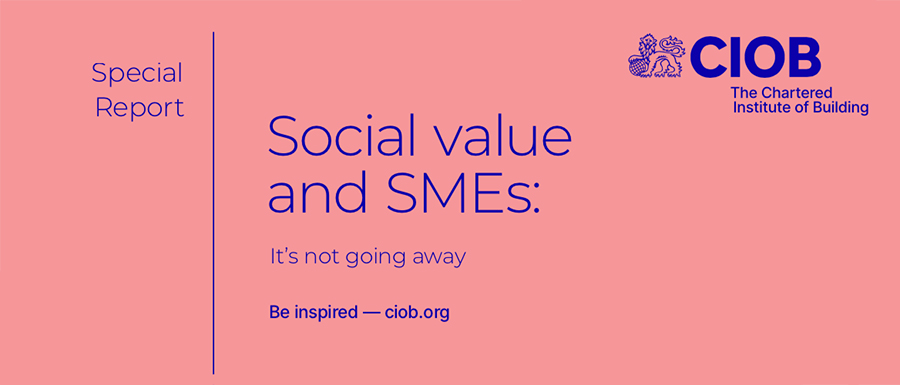Embrace social value or get left behind warns CIOB
Construction SMEs risk losing out in a competitive market if they don’t embrace the use of social value in procurement, so says a new report by the Chartered Institute of Building (CIOB).
The report, Social Value and SMEs, says a relatively small number of construction SMEs are up to speed with what social value is, how it is delivered and how it is measured. It predicts those who choose to ignore it will lose out when it comes to bidding directly for work in the public sector or for Tier 1 companies, who have had no choice but to move fast on social value since it was introduced into public sector procurement in 2020. It also adds that social value is more likely to feature in private sector procurement over time, as councils are expected to factor it into planning applications, meaning almost all projects will require its suppliers and contractors to demonstrate social value.
Saul Townsend, Head of Communications at CIOB, said: “Our advice to SME’s is to get on board with social value now. In lots of cases they’ll already be delivering it anyway, for example by recruiting locally, sourcing local materials, enhancing biodiversity, reducing carbon and engaging with local communities, but there is a need to understand how to record, measure and communicate these activities to potential clients. Demonstrating social value is not just great for winning work but also for attracting new talent into the workplace and it has a role to play in enhancing the industry’s overall reputation too.
“Our report demonstrates that businesses who are already on this journey are finding their own ways of capturing this valuable part of their work in a way that suits them. What is clear is that social value isn’t something to fear or shy away from and it certainly shouldn’t be seen as a box ticking exercise. It is here to stay and if SMEs want to be competitive, they need to get to grips with it fast.”
The CIOB report includes views on social value from within the construction sector, including from a representative from Sir Robert McAlpine, who explains how as a Tier 1 company they “rely enormously” on their supply chain to fulfil social value commitments, particularly on sourcing workers and materials locally and how those who bring solutions are “looked upon very favourably”.
It also features two SMEs from Northern Ireland who are embracing social value but say the current system there is unfair as there are no mechanisms for checking that social value pledges are actually delivered. They say companies can make social value commitments with no intention of fulfilling them, meaning they can undercut quotes from those who do spend the extra money on doing what they say they will. Both featured SMEs call for government bodies in Northern Ireland to refine the procurement process and develop a fair policy which means social value pledges have to be followed through.
The CIOB Academy offers a social value course, which is free to its members and £15 for non-members, and is also holding a social value seminar in July.
This article appears on the CIOB News site as "Embrace social value or get left behind warns CIOB" dated May 2, 2023.
--CIOB
[edit] Related articles on Designing Buildings
- Building social value.
- Corporate social responsibility in construction.
- Creating social value from civil engineering projects.
- Net Present Social Cost.
- Prosperity.
- Social benefits.
- Social cost.
- Social data.
- Social return on investment.
- Social sustainability.
- Social time preference rate.
- Social infrastructure.
- Social impact assessment.
- Social value.
- Social Value Act.
- Social value: Gearing up for giving back.
- Social value and design of the built environment.
- Social value in new development.
- Social value overview.
Featured articles and news
Government consultations for the summer of 2025
A year of Labour, past and present consultations on the environment, the built environment, training and tax.
CMA competitiveness probe of major housing developers
100 million affordable housing contributions committed with further consultation published.
Homes England supports Greencore Homes
42 new build affordable sustainable homes in Oxfordshire.
Zero carbon social housing: unlocking brownfield potential
Seven ZEDpod strategies for brownfield housing success.
CIOB report; a blueprint for SDGs and the built environment
Pairing the Sustainable Development Goals with projects.
Types, tests, standards and fires relating to external cladding
Brief descriptions with an extensive list of fires for review.
Latest Build UK Building Safety Regime explainer published
Key elements in one short, now updated document.
UKGBC launch the UK Climate Resilience Roadmap
First guidance of its kind on direct climate impacts for the built environment and how it can adapt.
CLC Health, Safety and Wellbeing Strategy 2025
Launched by the Minister for Industry to look at fatalities on site, improving mental health and other issues.
One of the most impressive Victorian architects. Book review.
Common Assessment Standard now with building safety
New CAS update now includes mandatory building safety questions.
RTPI leader to become new CIOB Chief Executive Officer
Dr Victoria Hills MRTPI, FICE to take over after Caroline Gumble’s departure.
Social and affordable housing, a long term plan for delivery
The “Delivering a Decade of Renewal for Social and Affordable Housing” strategy sets out future path.
A change to adoptive architecture
Effects of global weather warming on architectural detailing, material choice and human interaction.
The proposed publicly owned and backed subsidiary of Homes England, to facilitate new homes.
How big is the problem and what can we do to mitigate the effects?
Overheating guidance and tools for building designers
A number of cool guides to help with the heat.
The UK's Modern Industrial Strategy: A 10 year plan
Previous consultation criticism, current key elements and general support with some persisting reservations.
Building Safety Regulator reforms
New roles, new staff and a new fast track service pave the way for a single construction regulator.



























Comments
[edit] To make a comment about this article, click 'Add a comment' above. Separate your comments from any existing comments by inserting a horizontal line.